
For maintenance of internal environment (homeostasis), though one reciprocates other, sympathetic and parasympathetic parts of autonomic nervous system differ from each other as per following criteria:
- 1. Structural — Anatomical
- Functional: Physiological and Pharmacological
- Center: Center for sympathetic system is formed by antonomic neurons present in intermediolateral cell column of spinal cord extending from T1 to L2 segments.
Center for parasympathetic system is located partly in brainstem and partly in spinal cord. In brainstem the center is present in the form of general visceral efferent nuclei of following cranial nerves.- 3rd — Edinger–Westphal nucleus – in upper half of midbrain.
- 7th — Superior salivatory nucleus – in lower half of pons.
- 9th — Inferior salivatory nucleus – in upper half of medulla oblongata.
- 10th — Dorsal nucleus of vagus – in lower half of medulla oblongata.
In spinal cord, parasympathetic center is present in the intermediate area of 2nd, 3rd and 4th sacral segments of spinal cord. - Supraspinal control: Parasympathetic and sympathetic centers, as mentioned above, are controlled by nuclei posterior and anterior halves of hypothalamus respectively by hypothalamospinal tract.
- Autonomic ganglia: Autonomic ganglia of both the systems are situated outside the central nervous system and formed by synaptic connection between 1st and 2nd order of efferent neuron along with the cell bodies of postsynaptic neurons.
Sympathetic ganglia interconnected by vertically oriented chain of fibers called sympathetic chain (sympathetic trunk) are situated close to central nervous system (spinal cord) being paravertebral in position. The sympathetic chain is formed because fibers from each ganglia ascend or descend for one or two segments up and down before proceeding toward destination. As sympathetic ganglia are close to central neuraxis, postganglionic fibers are longer to produce more generalized activities on effector organ.
Parasympathetic ganglia are very close to the target organ, in the wall of viscera. So postganglionic fibers are shorter to produce more localized action. Physiological difference Both sympathetic and parasympathetic systems work in subconscious level, but they come into action in different environment.
Sympathetic system gets activated during emergency, stress or anger. This can be explained with a classical example. A man walks around a park in a pleasant afternoon. Suddenly, he is chased by a rabied street dog. The man runs away very fast to save himself from the attack of the dog when his sympathetic system becomes more active with the following changes in body.
- Heartbeat increases.
- Pulse rate becomes rapid with rise of blood pressure.
- Pupils get dilated.
- Vasodilatation of skeletal muscles due to muscular exercise.
- Extremities become cold due to peripheral vasoconstriction.
- Sweating due to hypersecretion of sweat glands.
- Erection of hairs due to contraction of arrectores pili.
- Tightening of anal and urinary sphincters.
- Heart rate settles down.
- Pulse rate gets slower with blood pressure settles down to normal level.
- Rate of respiration becomes slower with ‘snoring’ due to constriction of muscles of respiratory tree.
- Digestion of food gets promoted as a result of secretion of glands causing liberation of enzymes.
- Peristaltic movement of intestine is increased with
- Splanchnic vasodilatation due to ‘redistribution of blood’ from skeletal muscles and brain to gastrointestinal tract.
Source: Easy and Interesting Approach to Human Neuroanatomy (Clinically Oriented) (2014)